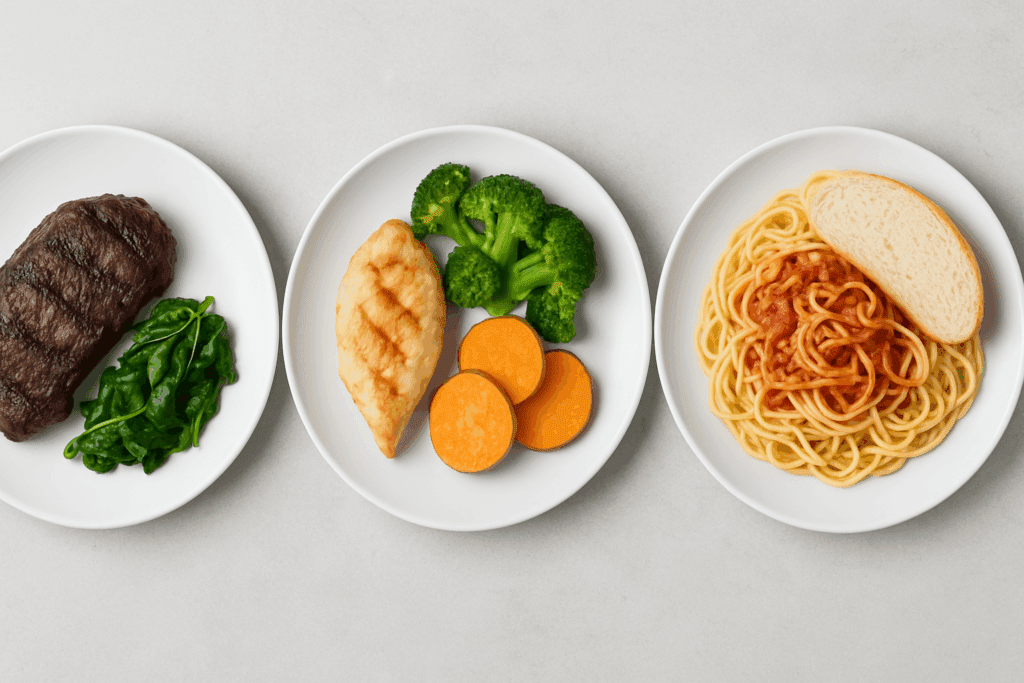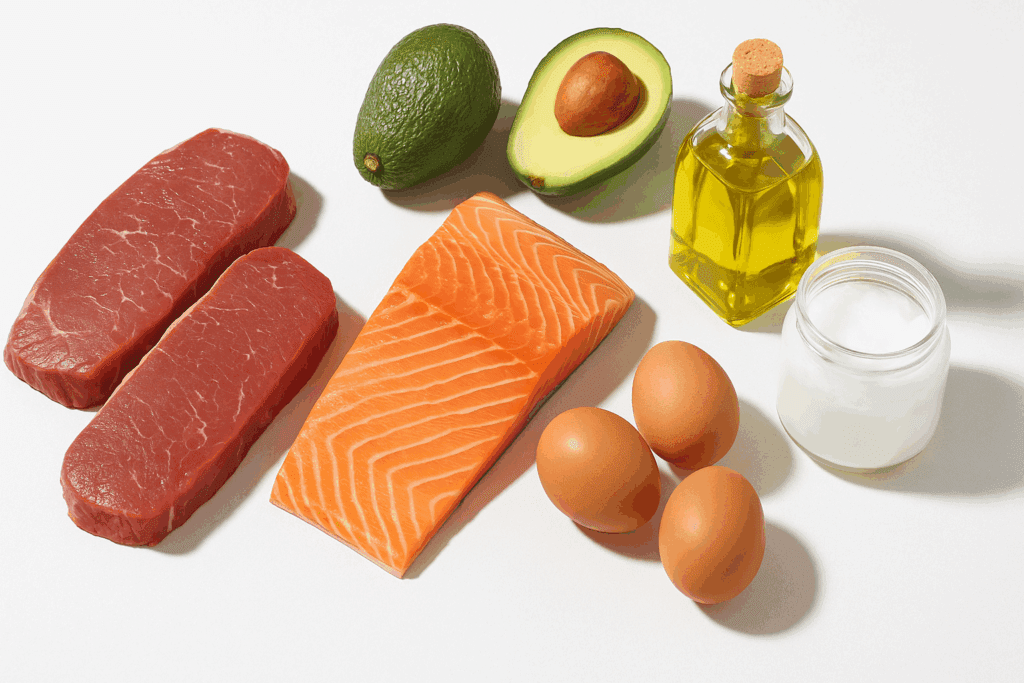In recent years, the low carb diet has transitioned from a niche weight loss strategy to a widely accepted nutritional approach for supporting metabolic health, managing chronic conditions, and promoting sustainable weight management. While diet trends often come and go, the evidence supporting the benefits of a low carb diet continues to grow. Yet despite its popularity, many people remain uncertain about what to eat on a low carb diet, how to identify appropriate low carb diet foods, and what level of carbohydrate intake truly qualifies as “low carb.” This comprehensive, expert-backed guide explores these questions in depth, offering practical insights, evidence-based advice, and a detailed exploration of low carb eating that goes far beyond the surface-level explanations often found in mainstream diet articles.
You may also like: Is the Keto Diet Safe or Dangerous? What Experts Say About the Risks, Benefits, and Basics of the Ketogenic Diet

Understanding What Is Considered a Low Carb Diet
To begin understanding what to eat on a low carb diet, it is essential to clarify what is considered a low carb diet in the first place. In general, a low carb diet refers to any dietary pattern that significantly restricts carbohydrate intake compared to the standard Western diet, which is typically high in grains, sugars, and processed foods. However, there is no universally fixed definition. In clinical and nutritional literature, a low carb diet may involve consuming anywhere from 20 to 130 grams of net carbohydrates per day, depending on individual goals, medical conditions, and metabolic factors.
A very low carb or ketogenic diet typically falls at the lower end of this spectrum, with carb intake restricted to less than 50 grams per day, often as low as 20 grams. This level of restriction encourages the body to shift from burning glucose for energy to relying on ketone bodies derived from fat. On the other hand, a moderate low carb diet may allow for up to 100-130 grams of carbs per day, which still offers metabolic benefits but with greater dietary flexibility. Understanding the low carb level that suits your needs is crucial when developing a diet plan for low carb diet success.

The Benefits of a Low Carb Diet: More Than Just Weight Loss
While weight loss remains one of the most recognized benefits of a low carb diet, its advantages extend well beyond the number on the scale. A growing body of scientific research has highlighted how reducing carbohydrate intake can lead to improvements in insulin sensitivity, lower blood sugar levels, and more stable energy throughout the day. These effects are particularly relevant for individuals managing type 2 diabetes, metabolic syndrome, or insulin resistance. Low carb diets have also been linked to reductions in triglyceride levels and increases in HDL (“good”) cholesterol, both of which are markers of improved cardiovascular health.
Furthermore, the low carb diet supports appetite regulation, often resulting in spontaneous calorie reduction without the need for strict calorie counting. This is due in part to the satiating effects of protein and fat, which play a central role in most low carb diet plans. Emerging evidence also suggests potential cognitive benefits, such as improved mental clarity and focus, especially when following a ketogenic version of the diet. Importantly, these benefits can be achieved while enjoying a variety of delicious and satisfying low carb diet foods, making this dietary pattern both practical and sustainable for many.

What Foods Are Low in Carbohydrates?
For individuals new to the concept, one of the most common questions is: what foods have low carbs? A key step in embracing a reduced carb diet plan is becoming familiar with the wide variety of nutrient-dense, low on carb foods available. At the heart of any low carb diet food list are non-starchy vegetables, high-quality proteins, and healthy fats. Vegetables such as spinach, kale, zucchini, bell peppers, and cauliflower are all examples of foods with least carbohydrates that can be consumed in generous portions.
In addition to vegetables, proteins such as eggs, poultry, beef, pork, and seafood all qualify as naturally low carb foods. These foods offer essential amino acids, iron, B vitamins, and other nutrients critical to health. Fats such as olive oil, avocado oil, nuts, seeds, and fatty fish like salmon and sardines round out the foundation of a balanced low carb diet. Many of these ingredients can be found on any comprehensive low carb diet list and serve as staples for meals that are both nutritious and low in carbohydrates.
Creating a Comprehensive Low Carb Diet Food List
Building a personalized low carb diet food list requires an understanding of what to prioritize and what to limit. As previously discussed, non-starchy vegetables should form the core of your meals. Leafy greens, cruciferous vegetables, mushrooms, and herbs are excellent choices. In terms of proteins, it is advisable to opt for minimally processed, high-quality animal or plant-based options. While some processed meats like bacon or sausages may be technically low in carbohydrates, they often contain additives, nitrates, or unhealthy fats, so it is best to consume them in moderation.
Dairy products can be part of a low carb diet, particularly full-fat options such as cheese, heavy cream, and Greek yogurt. However, be mindful of added sugars in flavored yogurts or milk alternatives. Nuts and seeds—including almonds, chia seeds, and sunflower seeds—are not only low in carbs but also rich in healthy fats and fiber. They are ideal for snacking or adding texture to meals. Oils like coconut oil, butter (preferably from grass-fed sources), and ghee are also commonly included in a low carb diet food list, supporting both flavor and satiety.

Exploring the List of Foods That Have No Carbs or Near-Zero Carbs
A common inquiry among those beginning this lifestyle is: what food has zero carbs? While most foods contain at least trace amounts of carbohydrates, there are indeed options that are effectively carb-free or extremely low in carbs. These include pure animal proteins such as unprocessed meats, poultry, and fish. Eggs are another nearly zero-carb food that offer versatility and rich nutrient content. Fats and oils, like those derived from avocado, olive, and coconut, are also considered to have no carbohydrates, making them ideal for those seeking a no carb no sugar diet.
It is also important to consider what foods have 0 carbs when planning meals that adhere strictly to ketogenic or therapeutic carb levels. Items such as bone broth, certain shellfish, and plain water-based gelatin may fall into this category. Understanding what are no carbs helps individuals remain within desired carb thresholds and ensures dietary compliance. However, it’s equally important to prioritize nutrient density alongside carb counts to avoid micronutrient deficiencies when choosing foods with least carbohydrates.
Clarifying What Is Considered a Low Carb Diet Food
For clarity, not every food that is marketed as “low carb” fits the nutritional profile recommended for optimal health. The question of what is considered low carb often depends on context. A food might technically be low in carbohydrates per serving but still contain refined ingredients, artificial sweeteners, or other additives that do not support overall wellness. When selecting foods for a low carb meal plan, it is best to prioritize whole, minimally processed items that are low on carb and high in nutrients.
Legumes, for instance, can be tricky. While beans are high in fiber, they are also relatively high in carbohydrates. Depending on one’s carb tolerance and daily goals, small portions may be appropriate, but they may not belong on a strict low carb diet food list. Fruits also fall into a gray area. While most fruits are high in natural sugars, berries like raspberries, blackberries, and strawberries are exceptions due to their fiber content and lower net carb count. Recognizing these nuances helps ensure long-term success on a reduced carb diet plan.
How Many Carbs in a Low Carb Diet? Determining the Right Intake
One of the most frequent questions among those starting this journey is: how many carbs in a low carb diet? The answer depends on the individual’s goals, health status, and metabolic flexibility. For weight loss or diabetes management, some may benefit from very low carbohydrate intake—typically under 50 grams of net carbs per day. This threshold is often used in ketogenic protocols designed to induce nutritional ketosis. Others may aim for a more moderate approach, consuming 75 to 130 grams of carbs daily while still reaping many of the benefits of low carb diet living.
It is also helpful to understand net carbohydrates, which are calculated by subtracting dietary fiber and certain sugar alcohols from total carbohydrates. This approach reflects the carbs that most directly impact blood sugar levels and is especially useful for those tracking carb intake for medical reasons. Ultimately, the best diet plan for low carb diet success is one that is sustainable, personalized, and based on informed choices about what foods are low in carbohydrates.

Low Carb, Low Sugar Foods That Promote Metabolic Health
Among the many advantages of this dietary strategy is the ability to reduce both carbohydrate and sugar intake simultaneously. Many low carb diet foods naturally qualify as low carb low sugar foods, meaning they help minimize blood sugar spikes and support metabolic stability. Leafy greens, cruciferous vegetables, avocados, olives, eggs, poultry, and seafood are just a few examples. These foods also tend to be rich in fiber, healthy fats, and essential vitamins, making them ideal for long-term consumption.
What makes this approach so effective is its alignment with the body’s natural mechanisms for hunger and satiety. Unlike high-sugar diets that promote insulin surges and energy crashes, low carb, low sugar foods help maintain steady glucose levels. This is particularly important for individuals struggling with insulin resistance, prediabetes, or polycystic ovary syndrome (PCOS). A thoughtfully designed low carb diet list ensures that daily meals are both delicious and beneficial for long-term health.
Is Low Carb Diet Healthy for Long-Term Use?
A common concern, especially among those new to this eating style, is whether the diet is safe for extended periods. So, is low carb diet healthy in the long term? Numerous studies suggest that when properly implemented, a low carb diet can be not only safe but highly beneficial. Nutrient density is key. By prioritizing whole foods that are low on carb and rich in essential nutrients, individuals can meet all their nutritional needs while enjoying improved metabolic outcomes.
However, it is important to be mindful of potential pitfalls. Poorly planned low carb diets that rely heavily on processed meats or lack sufficient fiber can lead to digestive issues and micronutrient deficiencies. A well-balanced reduced carb diet plan should include ample vegetables, moderate protein, and healthy fats to support digestive health, cognitive function, and cardiovascular wellbeing. Medical supervision may be warranted for individuals with chronic conditions, but for the general population, a low carb approach is a viable and effective dietary option.

What Happens If You Eat No Carbs for a Week?
While the idea of eliminating carbohydrates entirely may sound extreme, some individuals experiment with a no carb menu or carnivore-style eating plans for short periods. So, what happens if you eat no carbs for a week? Initially, the body shifts from glucose dependence to using fat-derived ketones as its primary energy source. This metabolic transition, often referred to as ketosis, may be accompanied by temporary symptoms like fatigue, headache, or irritability—commonly called the “keto flu.”
For many, these effects subside after a few days, and they experience increased energy, mental clarity, and reduced appetite. However, a strict no carbs no sugar diet should be approached with caution, as prolonged elimination of all plant-based foods can limit fiber intake and restrict essential phytonutrients. While short-term experimentation with a list of food that has no carbs may offer insight into one’s metabolic flexibility, most experts recommend incorporating at least a modest amount of low carb diet foods from plant sources to maintain overall health.
What Can You Eat on a Low Carb Diet? Putting It All Together
With so many options available, the real question becomes: what can you eat on a low carb diet that’s both satisfying and supportive of your health goals? The answer is both simple and expansive. Meals can include grilled chicken with roasted Brussels sprouts, scrambled eggs with spinach and feta, or salmon with cauliflower mash and avocado salad. Snacks might include cucumber slices with hummus, hard-boiled eggs, or a small portion of mixed nuts.
The key to success lies in planning and awareness. Reading labels, understanding portion sizes, and becoming familiar with what foods are low in carbohydrates allows for greater confidence and variety in meal planning. The right no carb menu or low carb diet list should reflect your preferences, cultural food traditions, and health goals. When approached thoughtfully, a low carb lifestyle can become an enjoyable and sustainable part of daily life.
Frequently Asked Questions (FAQ): What to Eat on a Low Carb Diet
1. How can I avoid boredom while following a low carb diet?
Boredom is a common challenge for people new to a low carb diet, especially when familiar comfort foods are restricted. One way to stay engaged is to explore global cuisines that naturally emphasize low on carb foods, such as Mediterranean, Thai, or Middle Eastern dishes. These cuisines often incorporate low carb diet foods like grilled meats, leafy greens, nuts, and olive oil in creative and flavorful ways. Additionally, experimenting with herbs, spices, and alternative flours like almond or coconut flour can refresh your cooking routine. Diversifying your low carb diet list with seasonal vegetables and rotating proteins also helps prevent dietary fatigue while maintaining adherence to your plan.
2. Can I do a low carb diet if I’m vegetarian or vegan?
Absolutely. Although traditional low carb diets often include animal products, there is a growing community of vegetarian and vegan individuals who successfully follow reduced carb diet plans. For vegetarians, eggs and dairy provide reliable protein and fat sources, while tofu, tempeh, seitan, and lupin beans work well for vegans. Nuts, seeds, avocado, and coconut-based products can further enhance a plant-focused low carb diet food list. While plant-based eaters may need to monitor their intake more carefully due to the natural carbohydrate content in legumes and grains, it is entirely possible to create a satisfying low carb low sugar foods regimen aligned with ethical preferences.
3. What are the psychological impacts of going low carb?
Transitioning to a low carb diet can affect mood, cravings, and overall mental clarity, especially during the early adaptation phase. Many people experience improved focus and fewer energy crashes after a few weeks, once their bodies adjust to using fat as a primary fuel source. However, others may notice temporary irritability or mood swings during carbohydrate withdrawal. Staying hydrated and ensuring adequate intake of electrolytes like sodium, potassium, and magnesium is essential to minimize this discomfort. Over time, the benefits of low carb diet adherence can include not only weight management but also better emotional regulation due to more stable blood sugar levels.
4. Are there benefits to carb cycling while on a low carb diet?
Carb cycling, or the strategic reintroduction of carbohydrates on certain days, may be beneficial for athletes or those with specific performance or hormonal goals. It allows for periodic consumption of high-carb foods without undermining the core benefits of a low carb diet. This strategy can help support intense workouts, replenish glycogen stores, and prevent the perceived deprivation that may accompany long-term restriction. However, it requires careful planning to avoid blood sugar spikes or regressions in metabolic health. Individuals interested in carb cycling should work with a nutrition professional to determine what is considered a low carb threshold for their body while safely integrating higher-carb days.
5. How can I travel or eat out without compromising my low carb goals?
Eating out doesn’t have to derail your diet plan for low carb diet success. Most restaurants now offer options that can be easily adapted to meet low carb needs—such as swapping fries for salad, requesting lettuce wraps, or asking for dressings and sauces on the side. Reviewing menus in advance and identifying low carb diet foods ahead of time can reduce decision fatigue. Additionally, packing travel snacks like jerky, nuts, or cheese can help you avoid high-carb temptations at airports or gas stations. Learning to navigate social dining situations is part of the long-term sustainability of a reduced carb diet plan.
6. What’s the difference between low carb and no carb diets?
While both aim to limit carbohydrates, a low carb diet includes a broad range of low on carb foods that may contain minimal carbohydrates, whereas a no carb no sugar diet seeks to eliminate nearly all carbs entirely. A strict no carb menu focuses on what foods have 0 carbs, such as pure fats and unprocessed meats, and typically excludes even vegetables and dairy. While some individuals experiment with zero-carb eating, it’s important to assess whether a no carb diet is good for you, especially in terms of gut health and micronutrient intake. Most people benefit from including a variety of nutrient-dense, low carb diet foods rather than strictly eliminating all carbohydrates.
7. Can a low carb diet help with conditions like PCOS or hormonal imbalances?
Yes, research suggests that low carb low sugar foods can improve symptoms of polycystic ovary syndrome (PCOS) and help stabilize hormonal fluctuations. Insulin resistance is common in PCOS, and a diet low in carbohydrates can reduce circulating insulin levels, which in turn can support hormonal balance and ovulation. The benefits of low carb diet strategies in this context include improved metabolic markers and potential weight loss, both of which are crucial for managing PCOS. It’s essential, however, to individualize the approach based on each person’s hormonal profile and to avoid overly restrictive eating patterns. Consulting with a healthcare provider can help determine what is considered a low carb diet that aligns with hormonal health goals.
8. What are common mistakes to avoid when starting a low carb diet?
One of the biggest pitfalls is not replacing electrolytes, which can lead to symptoms like fatigue, muscle cramps, and headaches. Another common mistake is relying too heavily on processed “low carb” products that may contain unhealthy fats or artificial ingredients. A more effective approach involves creating a low carb diet food list focused on whole, nutrient-dense ingredients. People also tend to underestimate hidden carbs in sauces, beverages, and condiments, which can interfere with progress. Understanding what foods are low in carbohydrates—and reading labels carefully—helps ensure your reduced carb diet plan stays truly low in carbs while providing the nutrition your body needs.
9. Are there performance drawbacks for athletes on a low carb diet?
While endurance athletes may adapt well to low carb eating, those engaged in high-intensity or anaerobic sports may experience reduced performance initially. This is due to the body’s preference for glucose as a quick energy source during intense activity. However, fat adaptation—achieved through sustained low carb intake—can eventually improve stamina and fat oxidation in some athletes. Strategic use of targeted carbs before events or carb cycling may help bridge the performance gap. Understanding how many carbs in a low carb diet works for your activity level is essential, and not all athletes will require the same low carb diet list to thrive.
10. What future trends are emerging in the low carb diet space?
As public interest in metabolic health grows, innovations are emerging around continuous glucose monitoring, personalized nutrition algorithms, and microbiome testing. These technologies can help tailor a diet plan for low carb diet adherence that’s uniquely suited to an individual’s biology. The demand for sustainable, plant-forward, low carb diet foods is also driving the development of new products like lupin flour pasta, jackfruit jerky, and ketogenic meal kits. Additionally, education around what foods have low carbs or what food has zero carbs is expanding, especially in clinical settings, as more practitioners embrace low carb protocols for treating chronic conditions. The evolution of low carb science continues to refine our understanding of what is considered low carb and how to make it practical, sustainable, and inclusive for diverse lifestyles.
Conclusion: Embracing a Low Carb Lifestyle with Confidence and Clarity
Understanding what to eat on a low carb diet empowers individuals to make informed, strategic choices that support not only weight management but also broader health goals. By focusing on nutrient-dense, low carb diet foods, incorporating a well-rounded low carb diet food list, and remaining mindful of what foods have low carbs or zero carbs, people can reap the full benefits of low carb diet living. Whether you’re exploring a reduced carb diet plan for weight loss, metabolic health, or cognitive clarity, this approach offers flexibility and personalization.
With a clear understanding of what is considered a low carb diet, how many carbs in a low carb diet plan are appropriate for your body, and which low carb low sugar foods to prioritize, you can move forward confidently. Rather than fearing dietary restrictions, view them as a guide to better nourishment. A well-structured diet plan for low carb diet success does not mean giving up joy in food. Instead, it encourages a shift toward foods that fuel your body more efficiently, reduce inflammation, and support lasting wellness.
Whether your path leads to a moderately low carb approach or a more defined no carb menu, the possibilities are expansive and rewarding. Ultimately, the best low carb diet is the one that aligns with your individual health goals, preferences, and lifestyle. With the right knowledge, preparation, and expert-backed understanding, anyone can thrive on a thoughtfully designed low carb dietary plan.
Further Reading:
66 Low-Carb Foods That Will Keep You Satisfied
What can you eat on a low-carb diet?
Low-carb diet: Can it help you lose weight?


